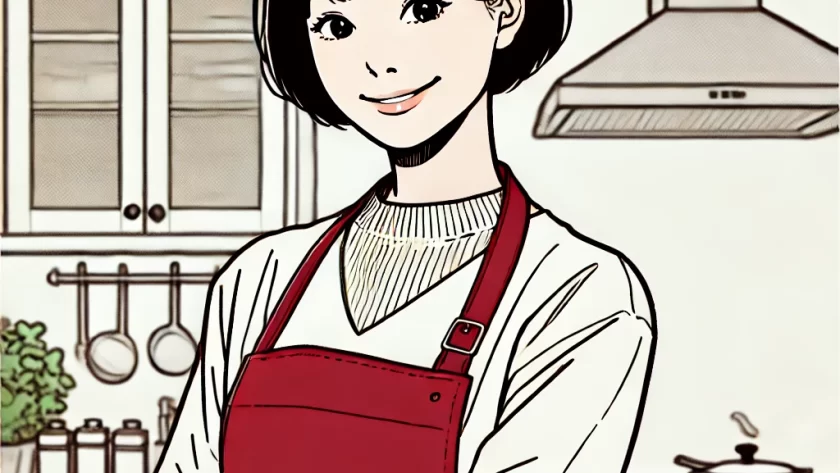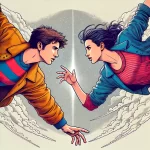恋 [Koi]
星野源 [HOSHINO Gen]
Words & Music : 星野源 [HOSHINO Gen]
The rising star Gen Hoshino, who has openly expressed his admiration for Haruomi Hosono and related music, is a singer-songwriter who also works as an actor and writer.
He led the instrumental band Sakerock from 2000, playing the marimba and guitar. From 2010, he focused on his solo career, gaining recognition while also appearing in various acting roles.
In 2016, he starred in the TV drama “Nigeru wa Haji da ga Yaku ni Tatsu YT” (based on a Hungarian proverb), for which he also created the song “Koi” as its theme song.
- 恋(こい) [koi] : love, romance
This drama is a romantic comedy based on a manga with the same title (English title: “The Full-Time Wife Escapist wiki“). The drama was a huge hit, and this song became Gen Hoshino’s biggest hit.
The drama is set in a household and includes themes like housekeepers and de facto marriages. While the lyrics are not directly related, there is a slight connection, which makes it worth considering when interpreting the song.
This drama also led to Hoshino marrying the heroine, Yui Aragaki.

営みの
itonami no
街が暮れたら色めき
machi ga kuretara iromeki
風たちは運ぶわ
kaze-tachi wa hakobu wa
カラスと人々の群れ
karasu to hitobito no mure
- 営み(いとなみ) [itonami] : activity
- 街(まち) [machi] : town
- 暮れる(くれる) [kureru] : to get dark
- 風(かぜ) [kaze] : wind
- 運ぶ(はこぶ) [hakobu] : carry
- カラス(からす) [karasu] : crow
- 人々(ひとびと) [hitobito] : people
- 群れ(むれ) [mure] : flock
(translation) “As activities wind down,
the town comes alive with color.
The winds carry along
the crows and flocks of people.”
意味なんか
imi nanka
ないさ暮らしがあるだけ
naisa kurashi ga aru dake
ただ腹を空かせて
tada hara o sukasete
君の元へ帰るんだ
kimi no moto e kaerun da
- 意味(いみ) [imi] : meaning
- ない [nai] : not exist
- 暮らし(くらし) [kurashi] : life
- ある [aru] : exist
- ただ [tada] : just
- 腹がすく(はらがすく) [hara ga suku] : to be hungry
- 君(きみ) [kimi] : you
- 元(もと) [moto] : origin
- 帰る(かえる) [kaeru] : return
(translation) “There’s no meaning,
just life that exists.
With an empty stomach,
I return to you.”
物心ついたらふと
monogokoro tsuitara futo
見上げて思うことが
miagete omou koto ga
この世にいる誰も
kono yo ni iru daremo
二人から
futari kara
- 物心つく(ものごころつく) [monogokoro tsuku] : to become aware
- 見上げる(みあげる) [miageru] : look up
- 思う(おもう) [omou] : think
- こと [koto] : thing
- この世(このよ) [kono yo] : this world
- いる [iru] : exist
- 誰も(だれも) [daremo] : everyone
- 二人(ふたり) [futari] : two people
(translation) “Once I become aware,
I look up and think.
Everyone in this world,
comes from two.”
胸の中にあるもの
mune no naka ni aru mono
いつか見えなくなるもの
itsuka mienakunaru mono
それは側にいること
sore wa soba ni iru koto
いつも思い出して
itsumo omoidashite
- 胸(むね) [mune] : chest
- 中(なか) [naka] : inside
- もの [mono] : thing
- いつか [itsuka] : someday
- 見える(みえる) [mieru] : see
- それ [sore] : that
- そば [soba] : beside
- いる [iru] : exist
- いつも [itsumo] : always
- 思い出す(おもいだす) [omoidasu] : recall
(translation) “What’s inside your chest,
the things you won’t see someday,
is being beside you.
Always remember.”
君の中にあるもの
kimi no naka ni aru mono
距離の中にある鼓動
kyori no naka ni aru kodō
恋をしたの貴方の
koi o shita no anata no
指の混ざり 頬の香り
yubi no mazari hō no kaori
夫婦を超えてゆけ
fūfu o koete yuke
- 距離(きょり) [kyori] : distance
- 鼓動(こどう) [kodō] : heartbeat
- あなた [anata] : you
- 指(ゆび) [yubi] : finger
- 混ざり(まざり) [mazari] : mix
- 頬(ほお) [hō] : cheek
- 香り(かおり) [kaori] : scent
- 夫婦(ふうふ) [fūfu] : married couple
(translation) “What’s inside you,
the heartbeat within the distance,
is the love I have for you.
The mix of your fingers and the scent of your cheek.
Go beyond being a couple.”
The concept of “Go beyond being a couple” is unique, and it seems to reflect the special love portrayed in this drama.

みにくいと
minikui to
秘めた想いは色づき
himeta omoi wa irozuki
白鳥は運ぶわ
hakuchō wa hakobu wa
当たり前を変えながら
atarimae o kae nagara
- 醜い(みにくい) [minikui] : ugly
- 秘める(ひめる) [himeru] : conceal
- 思い(おもい) [omoi] : thought
- 色づく(いろづく) [irozuku] : to color
- 白鳥(はくちょう) [hakuchō] : swan
- 運ぶ(はこぶ) [hakobu] : carry
- 当たり前(あたりまえ) [atarimae] : common sense
- 変える(かえる) [kaeru] : change
(translation) “Though it’s ugly,
the concealed thoughts color,
as the swans carry,
changing what’s taken for granted.”
恋せずにいられないな
koisezu ni irarenai na
似た顔も虚構にも
nita kao mo kyokō ni mo
愛が生まれるのは
ai ga umareru no wa
一人から
hitori kara
- 恋する(こいする) [koisuru] : to love
- 似る(にる) [niru] : resemble
- 顔(かお) [kao] : face
- 虚構(きょこう) [kyokō] : fiction
- 愛(あい) [ai] : love
- 生まれる(うまれる) [umareru] : to be born
- 一人(ひとり) [hitori] : one person
(translation) “I can’t help but fall in love,
with faces that resemble even fiction.
Love is born,
from just one person.”
胸の中にあるもの
mune no naka ni aru mono
いつか見えなくなるもの
itsuka mienakunaru mono
それは側にいること
sore wa soba ni iru koto
いつも思い出して
itsumo omoidashite
君の中にあるもの
kimi no naka ni aru mono
距離の中にある鼓動
kyori no naka ni aru kodō
恋をしたの貴方の
koi o shita no anata no
指の混ざり 頬の香り
yubi no mazari hō no kaori
夫婦を超えてゆけ
fūfu o koete yuke
(translation) “What’s inside you,
the heartbeat within the distance,
is the love I have for you.
The mix of your fingers and the scent of your cheek.
Go beyond being a couple.”
泣き顔も 黙る夜も 揺れる笑顔も
nakigao mo damaru yoru mo yureru egao mo
いつまでも いつまでも
itsumademo itsumademo
- 泣く(なく) [naku] : cry
- 黙る(だまる) [damaru] : silent
- 夜(よる) [yoru] : night
- 揺れる(ゆれる) [yureru] : sway
- 笑顔(えがお) [egao] : smile
- いつまでも [itsumademo] : forever
(translation) “Your crying face, the silent nights, and your swaying smile,
forever and ever.”
胸の中にあるもの
mune no naka ni aru mono
いつか見えなくなるもの
itsuka mienakunaru mono
それは側にいること
sore wa soba ni iru koto
いつも思い出して
itsumo omoidashite
君の中にあるもの
kimi no naka ni aru mono
距離の中にある鼓動
kyori no naka ni aru kodō
恋をしたの貴方の
koi o shita no anata no
指の混ざり 頬の香り
yubi no mazari hō no kaori
夫婦を超えてゆけ
fūfu o koete yuke
二人を超えてゆけ
futari o koete yuke
一人を超えてゆけ
hitori o koete yuke
(translation) “Go beyond two persons,
go beyond one person.”
It seems to suggest, “Let’s break through the concepts of being a couple or being single and move forward.”
As for the lyrics, there are many parts where the sentences are disjointed or difficult to understand. They are written with his unique sense of style.
In terms of music, while rooted in soul music and other forms of Black music, there are also unique Oriental sounds from the Chinese instrument, the erhu wiki, and Gen Hoshino’s specialty instrument, the marimba. These elements reflect the influence of Haruomi Hosono’s musical philosophy.
Another noteworthy aspect is the inclusion of young, distinctive musicians from the Black music genre in the backing band, such as Hama Okamoto and Ryosuke Nagaoka.
The dance from the music video, which has been viewed over 200 million times, was incorporated into the drama as the “Koi Dance,” sparking a nationwide trend in Japan. The choreography was done by Mikiko, who also worked with Perfume and Babymetal.
Thanks for reading! Feel free to comment if you have any feedback or questions.
Follow me on X.



